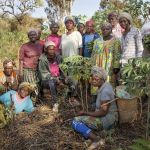Climate-Positive Agriculture: How Investors Can Support Smallholder Farmers – While Also Regenerating the Environment
Food systems leave one out of nine people undernourished — and with a world population that is expected to reach nearly 10 billion in 2050, food security is a growing concern. To meet the food needs of the expected 2050 population, global agricultural demand is expected to increase by about 50% compared to 2013, according to FAO. Endowed with natural resources and renewable water sources, Africa and Latin America are expected to see rapid growth in agriculture production and could be the solution to food security challenges.
However, if these regions grow more food using existing practices, it could also lead to major negative outcomes. Africa alone has an estimated 200 million hectares of uncultivated land — about 50% of the global total. Yet the expansion of current agriculture practices into this uncultivated land — which includes forests and other areas rich in plant and animal life — threatens biodiversity, causes the loss of natural carbon sinks and could accelerate the climate crisis. Agriculture contributed 12% to global emissions in 2017, but the sector was responsible for more than 60% of emissions in Eastern Africa. Furthermore, the people least responsible for creating the climate crisis will be the ones hardest hit by the consequences.
The Links Between Unsustainable Agriculture and Environmental Degradation
A lack of sustainable agriculture practices causes land degradation and puts additional pressure on farmers to expand their land use to maintain production levels. For instance, overgrazing has resulted in the degradation of 20% of the world’s grasslands, reducing agricultural productivity, increasing farmers’ vulnerability to the climate crisis and contributing to cropland expansion to compensate for low productivity. Land clearing and deforestation for agriculture causes loss, fragmentation and the degradation of native vegetation, destroying animal habitats and reducing biodiversity. Clearing land for agricultural purposes also requires breaking up the soil by removing rocks, roots and stumps, impacting soil and water health through erosion and loss of nutrients.
Agriculture is one of the industries most exposed to the risks of the climate crisis, and smallholder farmers lack resilience against these risks, putting their livelihoods in jeopardy. The increased frequency of extreme weather events affects crop yields and causes crop failures. For example, rising temperatures are expected to reduce global wheat yields by 6% for every degree (Celsius) of temperature rise. There are around 500 million smallholder farmers in the world, producing up to 80% of the food consumed in sub-Saharan Africa and Asia. One-third of the world’s population (about 2.5 billion people) depend on the sector for their livelihoods. However, farmers in low-income countries also have fewer resources for climate shock mitigation and adaptation compared to those in higher-income countries. Most smallholders depend on rain-fed agriculture and have little access to support to help them adopt climate-smart agricultural practices. Without support, the effects of climate change will make it more challenging for smallholders to produce food to meet global demands, as well as to sustain their livelihoods.
Ensuring global food security while building climate resilience requires increased investment in climate-smart and sustainable agriculture. In 2019, agriculture food tech investment reached up to $21.8 billion globally, having more than doubled in five years (it was just $9.05 billion in 2015). In Africa, the number of tech startups operating in the sector grew by 110% between 2016 and 2018. But despite this increase, many investors remain reluctant to offer affordable finance due to concerns about risk and low returns. Below, we’ll explore three approaches investors should take to increase sustainable production and long-term returns.
Making New Investments in Regenerative Agriculture
Investors should look to new types of investments in regenerative agriculture and circular economy practices to recycle and reduce waste while lowering emissions. Investments in new innovations can meet agriculture needs while reducing waste and emissions. A few potential focus areas and innovative organizations are described below:
- Insects for animal feed: Consumer demand for animal protein is expected to grow in line with the expanding global population and middle class incomes. In turn, the demand for animal feed is also expected to grow. Insects such as black soldier flies and mealworms can offer an alternative source of animal feed that requires less water and land and produces less carbon emissions in the production process than feed such as soy, while also consuming organic waste that might otherwise end up in landfills. Organizations such as ICIPE in Nairobi are actively working with producers of black soldier flies, such as InsectiPro, to improve farmer capabilities, with the aim of reducing pressure on agriculture value chains and reducing food insecurity.
- Permaculture: Practicing sustainable agriculture that mimics natural ecosystems can build soil health and productivity while providing year-round livelihoods for farmers. Greenpath Food in Ethiopia supports farmers’ efforts to turn small plots of land into food forests that increase incomes while reducing seasonal dependence on staple crops.
- Agroforestry: Planting trees alongside intercropping (i.e., the cultivation of two or more crops simultaneously on the same field) enables smallholder farmers to lock in carbon and build biodiversity while diversifying their incomes, often in remote areas with poor soils. Organizations such as Komaza and One Acre Fund are scaling these practices — for example, Komaza raised US $28 million in 2020 to propel their efforts — but much more is needed to ensure food security and carbon sequestration.
By expanding their investment portfolios into new areas of regenerative agriculture in these and other ways, investors can generate both financial returns and substantial benefits for the environment.
Greening Existing Portfolios
Investors can work with their existing portfolio companies to improve environmental practices, protecting marginal land and maintaining biodiversity while building long-term sustainability into these businesses. There is growing investor demand for more environmental, social and governance (ESG) investing within their portfolios, which offers a useful lens to help investors consider the environmental impacts of companies – including their carbon emissions, resilient practices and climate innovation. Technical assistance alongside investment allows investment funds to improve ESG standards within agricultural businesses. For example, Incofin IM has granted EUR 200,000 through the Technical Assistance Facility of the Fairtrade Access Fund (TAF) to support farming communities impacted by the COVID-19 crisis. TAF targets interventions focused on crop diversification, transitioning to organic production practices, climate change resilience and food security, supporting activities that will generate added value for farmers in Africa and Latin America and the Carribean. More broadly, investors can “green” their existing portfolios by improving organizational alignment with low-carbon growth, improving traceability across the value chain to facilitate responsible sourcing, helping companies to shift to renewable energy sources, and encouraging them to consider the emissions risk and adaptation needs across their operations.
Providing Suitable Finance to Support Smart Agricultural Tech Startups
Smart agricultural technology is starting to scale globally, helping farmers to increase yields and reduce loss. For example, AgroCares measures nutrients and other key parameters in soil, feed and leaves to support farmers, and Futurepump and SunCulture help farmers to expand the growing season and improve yields through access to small-scale, affordable solar pumps. However, margins for smallholder farmers are low, requiring the companies that serve them to set price points that make it difficult for them to break even. And even at lower price points, the upfront costs for smart agricultural technology are often too high for smallholders to afford, so getting this technology to more farmers requires financing.
Examples of new, innovative financing mechanisms that support climate-smart agriculture include:
- Patient capital: This refers to long-term capital made available on concessional terms — for instance, Acumen Fund’s approach.
- Revenue sharing with technical support: In this model, businesses are supported with investment, which is repaid through a regular share of the businesses’ income, while technical assistance provided through the investor helps to mitigate risks and ensure successful repayments. One example of this approach is Business/Partners in South Africa and Kenya.
- Commercial loan products: These include tailored loans for the agriculture sector. For instance, Crédit Agricole du Maroc provides meso-credit, which aims to bridge the gap between microcredit and traditional bank credit, tailored for medium-sized agriculture businesses in Morocco.
Whichever approach they take, it is up to the investment community to make suitable financing mechanisms more widely available — and to conduct research to identify context-specific tools to support climate-smart agricultural growth.
Through these and other models, investors, enterprises and other agricultural stakeholders can help the sector navigate the challenging transition to regenerative and resilient farming systems. Their efforts will be a key part of achieving the dual goals of ensuring global food security, while also preserving the environment for future generations.
Bianca Samson is Project Manager Kigali, Flavia Howard is Global Climate and Environment Practice Manager, and Kusi Hornberger is an Associate Partner at Dalberg.
Photo credit: Bioversity International.
- Categories
- Agriculture, Environment, Investing



